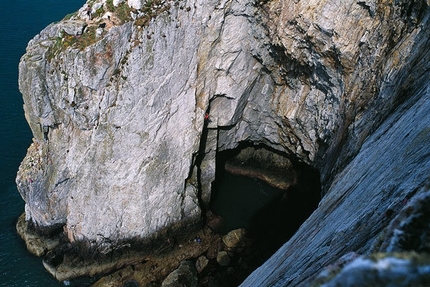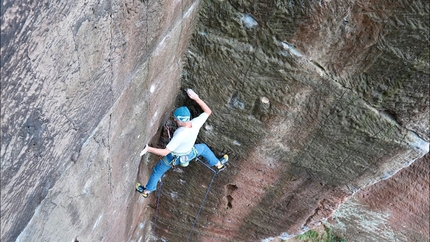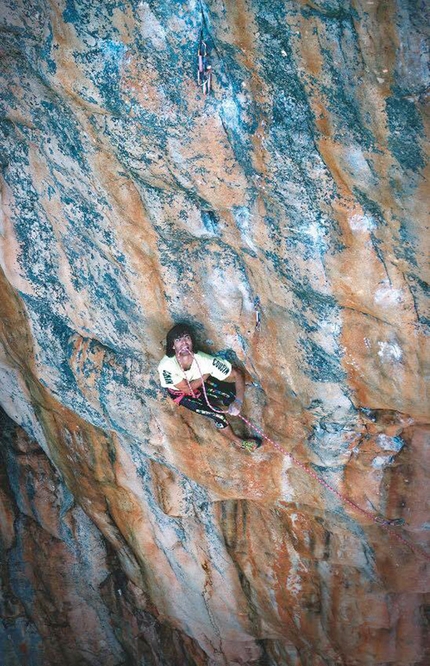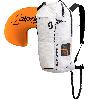Rob Matheson and 'The Bells, The Bells!' interview

 1 / 15
1 / 15 Neil Gresham
Neil Gresham
As previously reported, last April Rob Matheson made what can only be described as an astonishing repeat of The Bells, The Bells!, one of the boldest, least repeated trad climbs in Britain. Located on the imposing and atmospheric North Stack Wall at Gogarth, just off the island of Anglesey in North Wales, the route was first ascended by John Redhead in 1980 and celebrated as the UK’s first E7.
The protection is minimal and, due to its life-threatening nature, it had to wait six years for its first repeat, climbed onsight in a moment of pure inspiration by the late Andy Pollitt. In the last 45 years The Bells as it has come to be known has seen only a handful of ascents - according to the excellent website Climbing History just six.
There are few climbs in Great Britain held in as much awe as The Bells and Matheson's ascent, aged 74, beggars belief. A short film documenting the entire process has been produced by Coldhouse Collective and will be premiered at the Kendal Film Festival on Saturday 22nd November. In the meantime, Planetmountain was kindly granted this extensive insight into the ascent by the man himself.
The Bells, The Bells? What did this route represent to you, until recently? Presumably you can remember John's first ascent? Andy's audacious onsight? Mike’s amazing repeat?
Looking back, John Redhead’s ascent of The Bells in 1980 didn't really register with me. At the time, having climbed already for over 20 years, I was beginning to lose interest in climbing and was focused mainly in the Lakes anyway. In fact, I stopped climbing altogether in 1983 and didn't get back on the rock until 1990. I missed the training revolution, the explosion in grades, the explosion in sport climbing.
To focus on North Stack Wall, I led The Cad in 1999 and was really chuffed in that I didn't clip the bolt and only had a cursory look at the protection on the abseil into the zawn. The Bells, however, was not even on my radar, given its fearsome reputation and a frightening write-up in the guidebook.
It was Grant Farquhar’s amazing book, The White Cliff, which really inspired me into vaguely considering having a look at it. The essays transported me into another world which proved to be intoxicating. This was only two years ago! It was reasonable to assume that I had missed the boat! Unfortunately, I never met any of those legends back in the day, apart from Mike Owen who, to his credit, did climb in the Lakes!
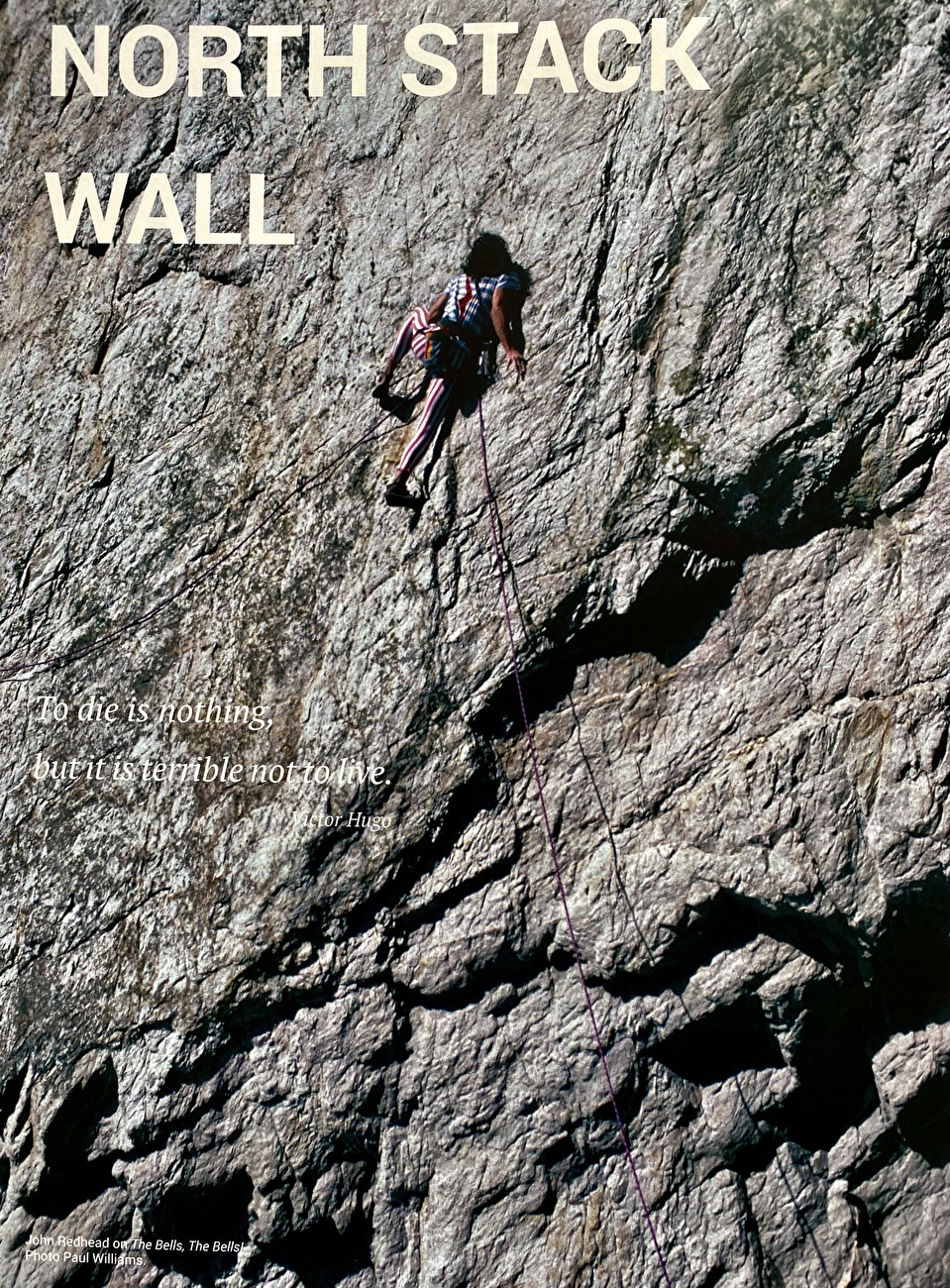
John Redhead making the first ascent of 'The Bells, The Bells' (E7) on the North Stack Wall at Gogarth in North Wales @ Paul Williams
Why did you choose this route in particular? Did you also consider other E7s? Which and why did you not go for them?
What has personally driven me in the last few years has been the desire to repeat several of my own routes, 50 years after the first ascent. This, in turn, led to filming them as a personal record and then to publishing them on YouTube under the tongue-in-cheek "Angry Pensioner Productions". Fortunately, I was not climbing too hard in my late teens, so 50 years later they weren’t too hard! Of course the plan is to continue in this vein, but as my first ascent grades get harder so does my age!

Paladin E3 5c. 50 years after my first ascent, providing that all important motivation... © Rob Matheson Collection
Inevitably I was struck by the idea of doing an E7 in my 70s - kind of poetic! So a couple of years ago I did Tombola, a classic E7 on Nescliffe in Shropshire. The Bells is just another classic E7 I suppose, so I started the process.
As you get older you have to pick your battles more carefully, so you choose your strengths and avoid your weaknesses. So I chose my feet and my mind. I am fairly comfortable on sea cliffs so I did consider other E7s on the North Stack Wall, such as The Clown, which were apparently safer but more strenuous. The decision, however, was cemented following a conversation with Niall Grimes at the Kendall Film Festival a couple of years ago. His wise words cut through — "yes: but The Bells is The Bells is The Bells, and the others are not". I'm sure Niall thought I was in cloud cuckoo land anyway to even consider such madness!
Rob, for those who have never climbed at Gogarth in general and the North Stack Wall in particular, can you tell us a bit about the sea cliff and it's ambience?
I almost feel that I cannot do justice to this question. It is a place that either gets into you, or you rejected it out of hand. I love it. I feel relaxed on it. But it can spurn you if you fail to respect it. This has been written about many times by those more qualified than myself, but the North Stack Wall is a special place. White, hard, brittle and ancient! Enough said!
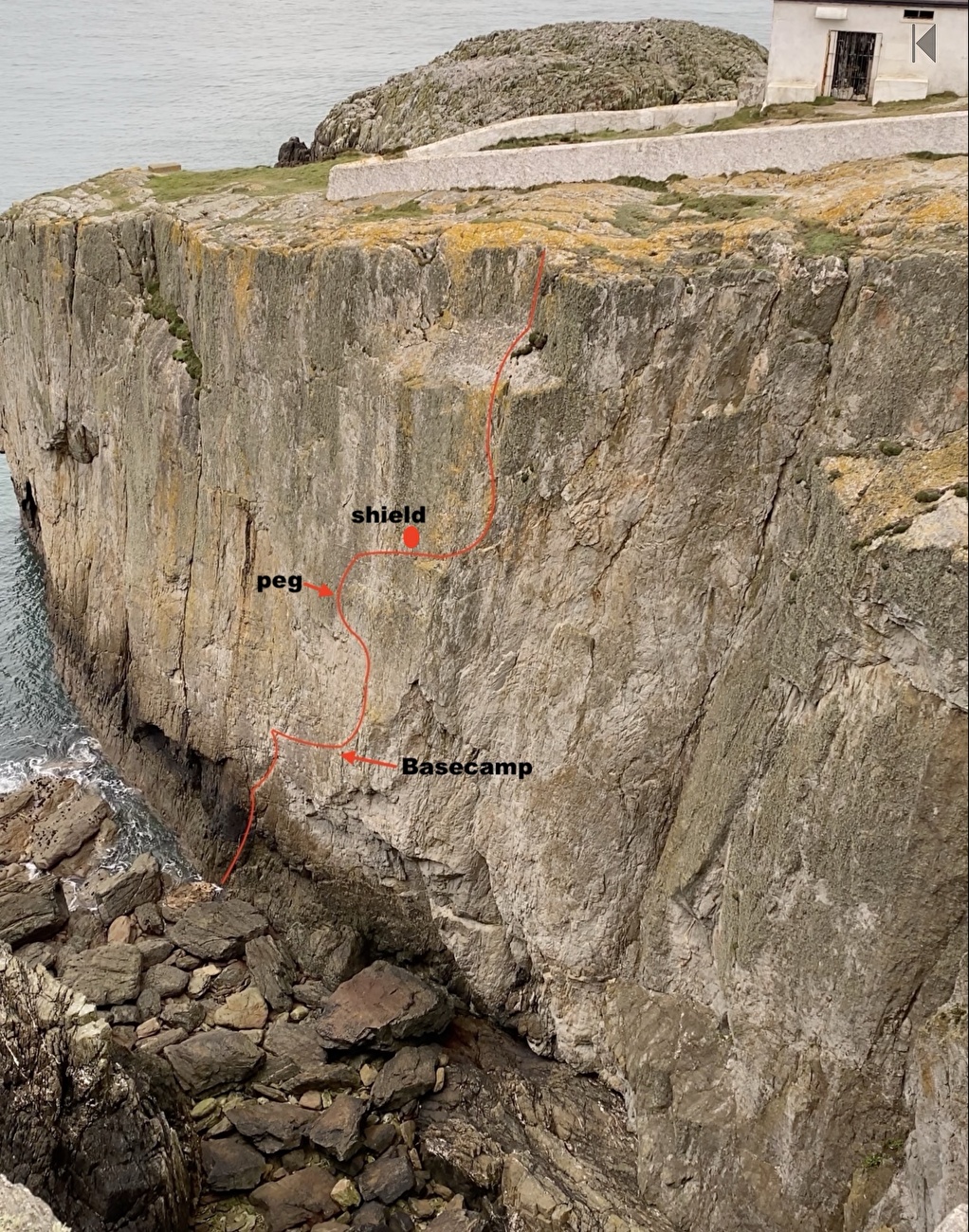
The line of 'The Bells, The Bells' (E7) on the North Stack Wall at Gogarth in North Wales © Rob Matheson Collection
On The Bells, what's the actual climbing like? How hard is it? How cruxy? What's the rock like? And the gear?
It's a long complex pitch. Very unforgiving and not at all obvious. This is perhaps why it has only been on-sighted by elite climbers at the top of their game, who are able to retreat from blind alleys, re-assess and continue. You need a few grades in reserve! The rock quality is fine but it has to be treated with respect. Tread softly and handle with care. My protection video on YouTube highlights the protection challenges, but I thought as a headpoint it was okay. But I'm used to climbing on spaced, marginal gear and have used hooks as ‘retreat’ gear for decades. Hanging on to place clusters of marginal gear saps your mind and body, and by the time you get to the crux you're pretty tired. Then you have the honour of ‘eye-balling’ that peg. You either reach it or face the consequences. Simple. These are the moments in time which are significant. The ones you remember. Nothing else matters!
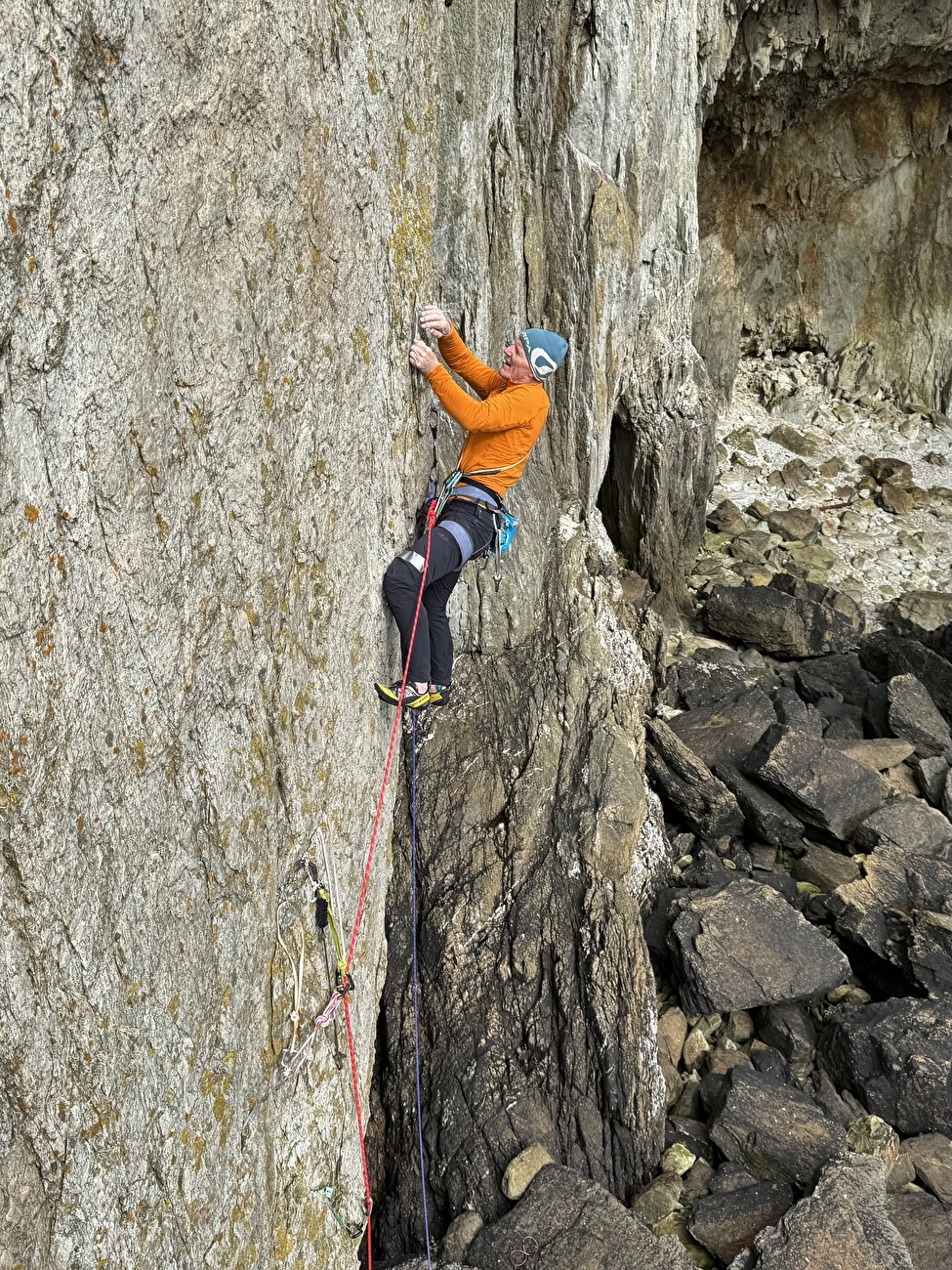
Marginal gear and hooks. Ready to really commit © Neil Gresham
You abseiled in on your own to inspect it. What were your first impressions at the time?
All of this has been covered in my Bells Youtube videos. When you want to do something, no matter how outrageous it seems, you’ve got to get off your backside and start the process. This first step is often the hardest but can be the most significant. You don’t need anyone else at this stage. You’re on your own. So I drove for 4 hours, walked for 40 minutes and abseiled in for a look. I could have still been sitting in a chair, staring at the telly, but I was staring at the peg on the Bells! Enough said! My mindset was as if I was doing the first ascent: what’s the line? Where’s the gear? Where’s the rests? Crucial sections?
At the end of that first day I was impressed by the complexity of the line and the seemingly unrelenting nature of the climbing. Certainly in your face! But I thought it was my style and I could perhaps do it, but only as a ‘Head point’, as I would have nothing in reserve.
Was this a stressful process? Did you have inner Demons? How did you deal with them? When and why did you decide to go for the lead? How did you feel? What went wrong? What went right?
The whole process was exciting and only became stressful when I felt pressured into going for the lead. I had laid my cards on the table with part one and part two videos on YouTube. Stop ‘dancing around your handbag’ and get on with it. My "public" were waiting for their day and I regularly had to field well-meaning comments on whether I still intended to go ahead with it, or "have you done it yet?" It was The Bells and it wasn't me who had given the route a fearsome reputation, it was 45 years of existence within the climbing community. There must be something in that.
The ‘sharp end’ day had to be organised, with all your mates aligned to the cause. Filming, cajoling and holding the rope. Purposefully I never told the curious to come along and watch! It was late March; very cold and windy. I had not led a trad route for nearly a year. I had a nasty absess on a tooth, not slept properly for ages, and I was nearly 75 nursing the usual aches and pains. My team of experienced and respected climbers, my son Craig, Neil Gresham, Charlie Woodburn and Terry Smith, wondered what all the rush was about and advised that this was certainly not the best day! Apart from that, all was good to go!
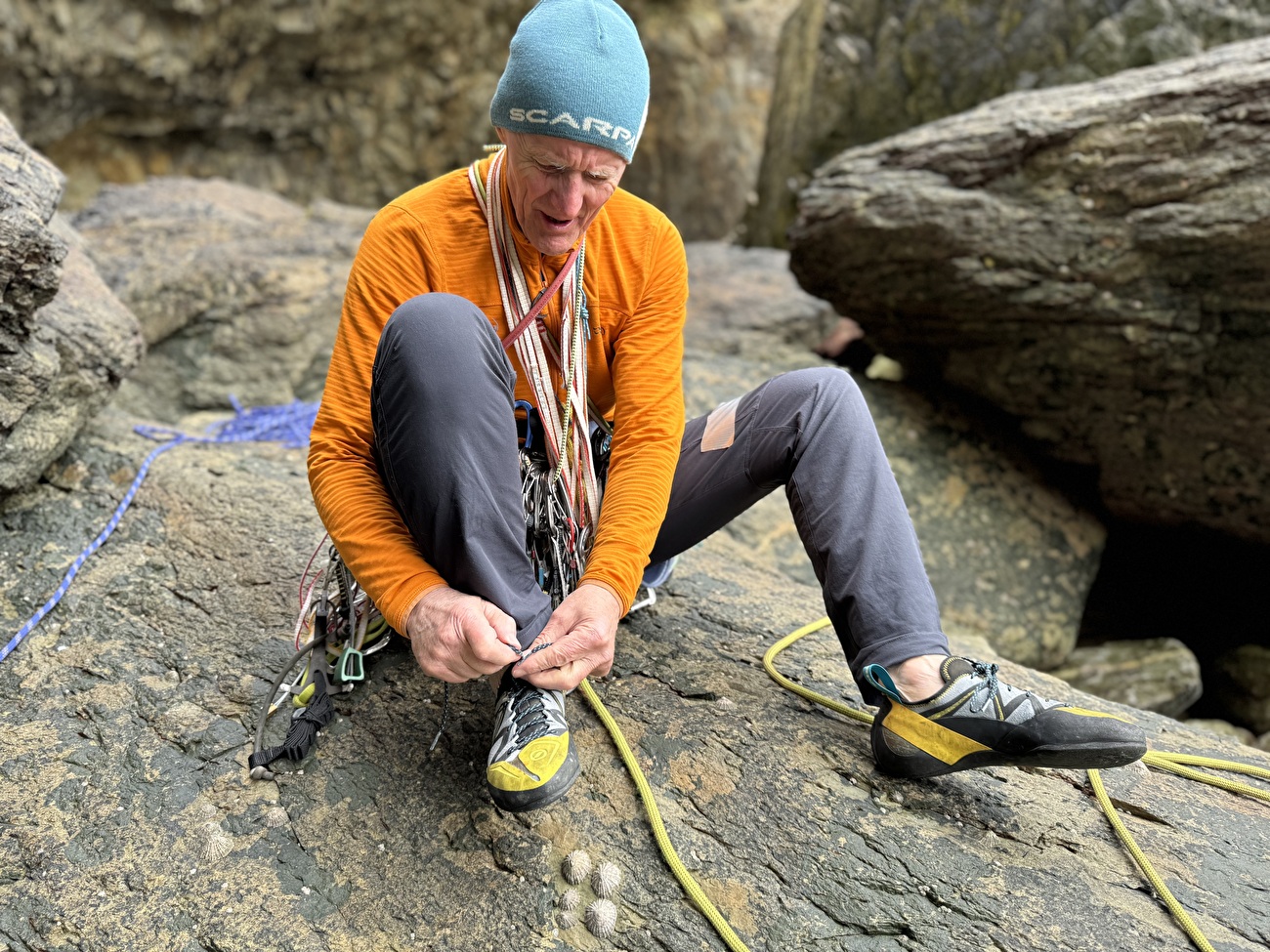
Nervous focus before the first ‘sharp end’ © Charlie Woodburn
To add to the difficulties, the route isn't exactly in your backyard.
Anywhere between 3 1/2 to 5 1/2 hours to get there. On numerous visits, I was on my own and certainly got fed up with the M6, M56 and A55 snarl ups. Often I would stop over at Premier Inn in Holyhead, which was fairly cheap over the winter months. Unfortunately, the prices started to go through the roof as spring approached and I was forced into occasional daily forays which was totally knackering.
E7 falls are sketchy. All the more so on The Bells. But then you returned… with what mindset?
My perspective is that if you're headpointing a route, you should not have any pre-placed gear at all and so the crucial part for me was clipping the peg without any sling on it! A new peg was placed about 20 years ago, a bit higher than the original, and the crux for me was clipping that naked peg. I suppose those moves to the peg demanded that extra bit of focus, so I took more time and care to make it safer. With that in mind I screwed a few holds on my garage wall for the two or three moves involved in clipping the peg - how sad is that!
I suppose that was the only specific training I did for the route. Basically what I'm saying is that falling off is only ‘safe’ once you have the peg clipped, but only if you are below or level with it. That was where I fell, on that cold and windy day in March, exhausted, after enduring several, finger sapping, gear cock-ups and just managing to get the wind-blown sling looped over the protruding peg. The peg and a lower hook saved me!

Eying that iconic peg! © Neil Gresham
How did you feel?
I was not a happy man! All that effort and so nearly there! But this was the "here and now". In life, opportunities should not be squandered - but was this still an opportunity? I had a full-on body shake, probably caused by a mix of the cold and, no doubt, the adrenaline/emotional release. Needless to say my whole body also felt totally pumped! Great supportive mates kept it light hearted, and this was followed by extra layers and a lovely cuppa tea. But this was my day, and my decision: "Strip the gear!" Silent whispers of dread followed! But an hour later the tide demanded action, so I set off for a second attempt, pulling hard up The Cad and pushing the jeopardy button as I entered The Bells. In retrospect it was not surprising that I was feeling somewhat jaded and I knew I was in trouble after I placed the crucial runner. It just fell out; disappearing into the yawning boulders below. Not good! Nevertheless I just pressed on, relying on my reserves of control which I’m supposed to have in abundance. And suddenly there I was, staring at that naked peg again, squinting into the sun, trying to get that wind-blown loop over the eye. And yes, hanging on like grim death. Then it was done, but I was gone; I slumped onto the gear in utter failure. Obviously I was not fit enough!
Belayed by your son! That’s quite a choice too…..
Craig and I have climbed together for years and we are totally used to holding each other's ropes. After all I spent hours holding his ropes on Hard Cheese - that protectionless and so far unrepeated testpiece high up in Langdale! I suppose we have developed a confidence in each others judgement on bold poorly protected routes. We always discuss protection and Craig always gives it an extra analytical eye. I'm very much more "that will do - let's get on with it." We sometimes disagree, but the leader of the day always has the final say!
Incidentally on my attempt effort in March it was Terry, a longtime friend of mine, who was holding the rope. Craig was filming on the other side of the zawn and was so nervous watching that he vowed to hold my ropes next time. A two belayer approach with three ropes, one rope for the start up The Cad and across to ‘base camp’, then the other two for the rest. The Cad rope is then abandoned to save weight and avoid drag.

Craig Matheson on the incredibly bold ‘Hard Cheese’ at Langdale, Lake District, England © Matheson collection
So what can you remember about your successful ascent? Can you describe your state of mind at the time? How in the ‘flow’ were you, physically and mentally?
A mix of emotions really. In many ways I was fed up with The Bells journey and desperately wanted it put to bed. That self-inflicted media pressure was very real and I was surprised by how much it affected me. The intensity had increased through the winter months and as we entered March I felt lured to sampling that ‘sharp end’ feeling and, as previously said, against the advice of my experienced mates. Indeed Craig privately inquired if I had some sort of terminal condition causing me to rush! The March failure really aggravated the hell out of me as there were loads of mistakes made, and until I got the next opportunity, about a month later, my company was not the best. So when the April opportunity arose I was totally ready to go.
Geared up with the tide lapping at my feet. Nervous - yes. Focused - yes. I had entered that magical silent world where nothing else matters. I was totally self-contained, self- reliant and at one with all before me. Maybe trance like. But we've all been there. Occasional movements, that aren't quite perfect, wake you a little, only to refocus in a stronger mode. Then I'm there below the crux moves and suddenly the trance disappears. Reality rears it's ugly head. Look down and start doubting the marginal gear; look up and start stressing about reaching that peg of sanctuary. Then calm; and enter that silent world once more. The familiar caresses of the fingers and the precision of those toes: elegant then brutal, pushing past that self-doubt. A strange feeling beyond the crux, of total control and focus. Take your time! More marginal gear to the technical ballet moves across the traverse, passing ‘The Shield’ and eventually onwards into the final exit groove. Extra focus here. Not too hard but the scene of historic emotional epics. I experience a controlled slow burn euphoria as I pull over the top and only then do I let go. Releasing my personal rage against the dying of the light.

Rob Matheson topping out from 'The Bells, The Bells' (E7) at Gogarth in North Wales © Ade Nelhams
Amazing. Out of interest, why your ascent now and not years ago?
I suppose in many ways I've already answered this question. Many top climbers in the past did not do The Bells because of its fearsome reputation. I was not a top climber so I didn't even consider The Bells. That was for others. Why today? What has changed? A good question. I suppose the motivation to accomplish dreams grows as you get older. The Bells has only really become a dream over the last two years perhaps because, deep down, it was unattainable hence reasonable to abandon it at any stage. It was personal, but being an ‘open’ type of person I did share the idea with all and sundry. Other people’s opinions and reactions varied, from the astonished to the dismissive, but a small group of friends remained very supportive behind the scenes. It was only after I had inspected the route and broke it down, as if I was doing a first ascent, did I realise that it was actually within my reach?

Rob Matheson at ‘Base Camp’ having just dropped the Cad rope. Eying up the start of the real difficulties. © Charlie Woodburn
Rob you’re 74. Has your climbing changed over the years? Physically and psychologically? What have you noticed you the most?
My thoughts and experiences since I retired, from 40 years of teaching, at the age of 60 is a long and convoluted explanation. To put it in simple terms I have found that my mind is generally bearing up better than my body. Head pointing, I suppose, is my new safe zone as sport climbing is for others. I still prefer on-sight trad climbing but I have to travel to completely new venues to have any choice, as locally only headpoint challenges remain.
As you get older you have to be more selective with your targets. Choose your battles carefully! As I have always been a comparatively weak climber, I could only get high E grades by taking on the more poorly protected and bold challenges so I am used to that type of climbing. A well protected E7 would be far too strenuous for me and, of course, this is my problem with harder ‘sport climbs’, unless they are slabby. Stress the muscle groups too much, particularly your weaker ones, then the risk of injury increases.
After I turned 70 I have tended to train my strengths but only caress my weaknesses. Regular 80% rather than irregular 100%! I do carefully listen to my body, but recently I have found that my body is developing an infuriating habit of not talking to me! So injuries just come from nowhere!

Reaching to place the hook before starting the technical traverse to ‘The Shield’ © Neil Gresham
You are renowned for your trad climbing, above all in the Lake District. What’s your relationship with sport climbing though?
Sport climbing in the UK has never really sat comfortably with me. Climbs under 7a in standard are usually of poor quality and at unattractive venues. Hence the migration of climbers going abroad in search of quality routes in the 6s. Then many climbers get drawn into the project /redpoint game which can be soul sapping on popular classic routes in the UK. But after I retired I did get hooked into some of this style and redpointed routes like, Obsession on Malham and Cave Route Right Hand at Gordale and, dare I say, Hell’s Wall on Bowderstone (which is of that clip up style). Many of my mates went on into the 8s, but I got the odd injury which halted my progression to the magic 8a. I get more satisfaction from choosing a hard, poorly protected trad route and grabbing a few E7s in my 60s and obviously into my 70s. The 8a sport route in my 70s holds no poetic challenge so I will have to wait until my 80s for that! In other words, I’m sure that particular ship has sailed. Having said all that I do totally understand why sport climbing is so popular and I do really enjoy my trips abroad, particularly to Kalymnos which, even today, despite the crowds, is a great place to holiday. I mean sport climbing is certainly logistically a lot easier than Trad climbing, as is bouldering and indoor climbing, but for the life of me, I don't see the point in spending days trying to get my arse off the floor on a classic boulder — hey ho!!
Watching your YouTube videos one can easily get hold of your typical British and Lakeland understatement, but surely this Bells ascent is special to you. If so what are you most proud of?
I suppose I am proud of doing The Bells because most climbers, including friends, thought that this was maybe one step too far. I also have done very little Trad climbing in the last few years and was relying on that deep experience that hopefully would come to the surface. And it did! Over time I've done most of the trad climbs in the Lakes that are below E7 so for me only head pointing remains, and only for those within my raw strength range. "If you can't pull it you can't do it" still holds true, and the window of strength gain is realistically nearly shut.
I'm obviously proud of my own first ascents, some of which have received classic status over the years. Many young climbers today don't appear to have much sense of history and I often get "oh is that one of your routes?" It's a good feeling when people appreciate your climbs, in that you have had the honour of naming the route even though it's not your personal property. I recall Alan Austin once saying to me that people enjoying his climbs was one of the great pleasures he got out of climbing. I can certainly relate to that. I often joke with Craig that the problem with his new routes is that they are too hard for others to climb, never mind enjoy! Maybe that will come in the future. It is not unusual for very hard routes to be ignored by the leading climbers of the day, only to be rediscovered a decade later.
So back to The Bells. I do feel humbled and have a sense of achievement in doing such an iconic route and hopefully it has helped to raise the profile of Trad climbing and the idea of risk and jeopardy being a worthwhile pursuit. If it has inspired others to challenge themselves then that would be great!
E7 at 70. Following the trend, E8 when you're 80?
Everyone has something more to give. Not peaked yet!? See what happens! Just keeping that Mind and body together! I’ve said this before, but as you get older it becomes harder to try hard. So achieving in your ‘comfort zone’ becomes more attainable! Make of that what you will! I would advise to set a target a little beyond what you think you can do. And then get on with it!
Just to put things into an historical context, I seem to remember you started climbing in the 1950s with hemp ropes and nailed boots, …. what was climbing like back then?
I personally did not have nailed boots, but my Dad did. I might add, he soon stopped climbing in them when he bought some rubber soled boots. Hemp ropes initially yes, but very quickly replaced by Viking nylon. Climbing back then was all fun and do what you want. No rules with minimal knowledge. Just the family and very local, with limited transport. Guidebook led. Very bold with no runners. Rope tied round waist. Never fall. Never go to your limit. Down climbing experts. Slowly embrace new technology such as carabiners. All climbs of one grade to be done before going onto the next. Tick off the routes. Earn the right to go on to the next grade. No instant gratification — all had to be earned!

Rob Matheson's father, Murdoch, on Lliwedd in the 60s © Rob Matheson Collection
So what did trad climbing represent to you as a youngster? And what does it represent to you now?
Trad climbing was always starting at the bottom of a crag, and using the guidebook, plotting the line and setting off. That was the challenge within your chosen grade. As you moved through the grades, the method remained the same. When you personally reach your ceiling you strive to get more information. This can be just talking to others and getting advice or information about that route. You still start from the bottom. Then you start failing; plenty of down climbing, perhaps lowering off a runner, perhaps even falling off, only then to pull the ropes and return another day. But leave the runner in. And yes it’s easier next time. But still, all from the bottom. But then one day you may leave the rope in the highpoint, and go again, and then it’s even easier. But still get the tick! Then maybe just abseil down the line and check a few things out, clean a few dirty holds, where are the runners? That ones hard to place so I’ll leave it in! Can I stand here and rest and so on. And then one day you may even top rope a section!! If you have been doing new routes you may have been doing all of this stuff anyway, and often you are the best climbers leading the pack. Some first ascent videos have even shown runners already in place. God forbid! So the ‘human’ process goes on. Every climbers perspective is different. Inevitably! Messy! Ethics! Controversies! Opinions! On sight, ground up, flash, yo-yo, headpoint, redpoint, beta and many more no doubt. At the end of the day climbing is freedom, and you can do what you want as long as you preserve the rock and are honest.
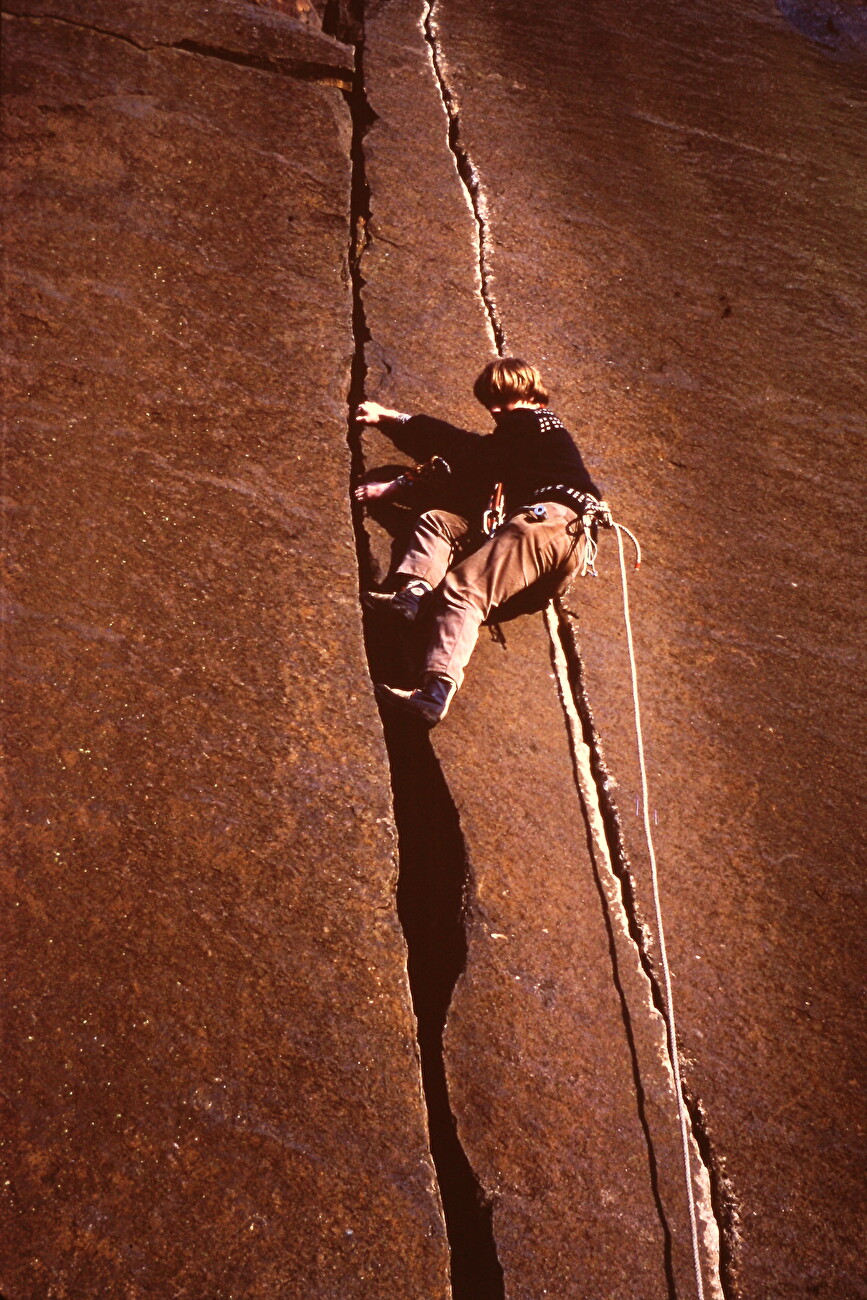
Trad gear in the late 60s on Millstone © Rob Matheson Collection
I suppose that is why sport climbing is now so much simpler, in that you can do any amount of preparation you want. All that matters is the final redpoint. Perhaps the main difference is that Trad climbing is more complex due to the self-protection issues and potentially greater mental challenges to keep the self safe. Failure is likely to have more serious consequences. It is a natural human instinct to mitigate against risk and that is perhaps why Trad climbing ethics are so varied and complex. In my mind there is a one or two E grade difference between a true onsight ascent and a headpoint ascent. That assumes all gear placed on the lead. Pre-placed gear may reduce that grade even further!? The hardest Trad routes today are not really graded for the on- sight but for the headpoint. Discuss!! Fashions and perspectives change with time. It seems to me that most climbers today value the idea of prior knowledge, and it is the execution of movement that is more important than unravelling the unknown or interrupting the flow with gear placement. Fear of failure is hard enough to deal with. That extra risk and jeopardy is for others!
But Trad climbing, for me, represents the most complete discipline in our sport. It encompasses all climbing challenges within its vast array of grades. It takes time to learn and cannot be rushed. It is certainly all shades of grey and remains a haven for the more adventurous souls.
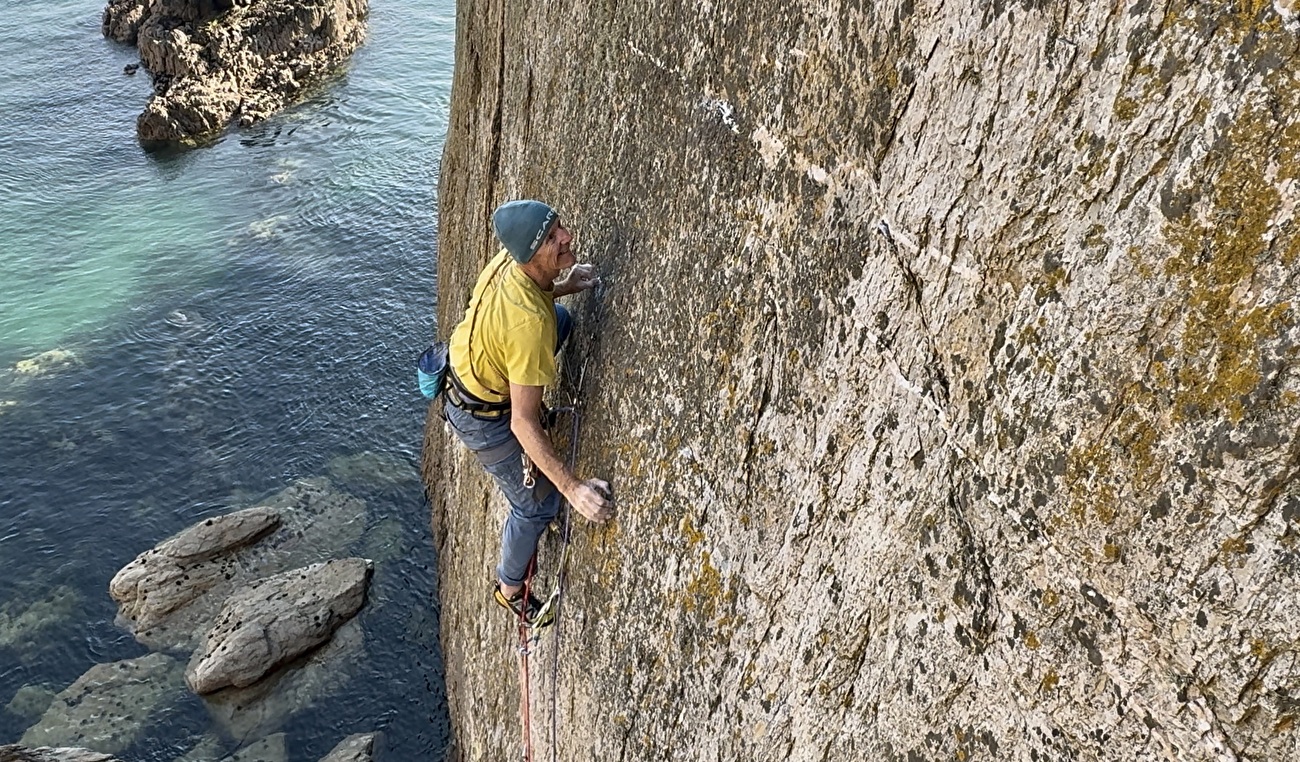 Bold delicate moves above the peg add to the feeling of insecurity. Rob Matheson repeating 'The Bells, The Bells' (E7) on the North Stack Wall at Gogarth in North Wales © Charlie Woodburn
Bold delicate moves above the peg add to the feeling of insecurity. Rob Matheson repeating 'The Bells, The Bells' (E7) on the North Stack Wall at Gogarth in North Wales © Charlie Woodburn



 Copia link
Copia link

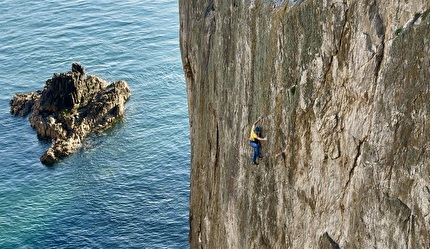

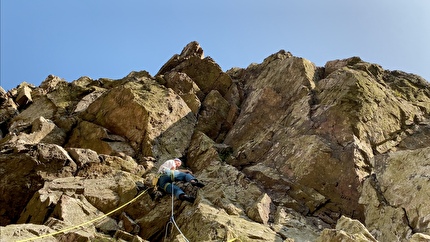



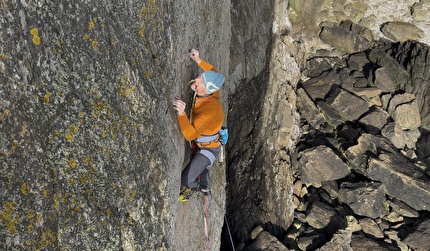

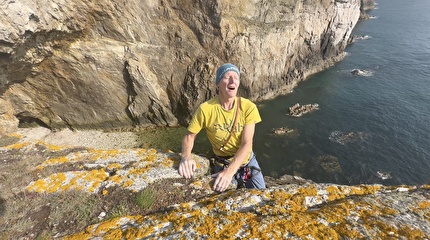
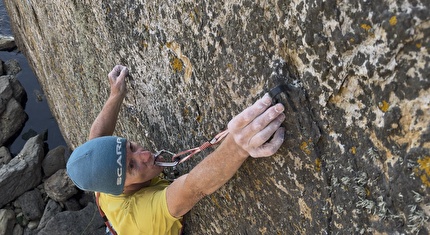
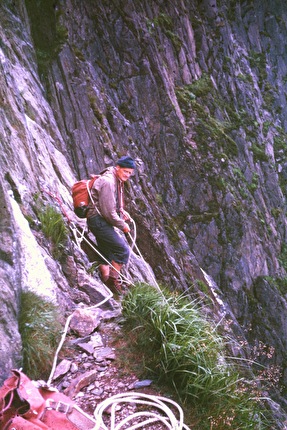

 See all photos
See all photos